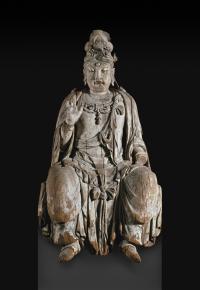Ashmolean Museum

(c) Ashmolean Museum, University of Oxford
Date: 13th century
Culture: Buddhist
Country of origin: China
Accession number: EA1982.2
Location: Ground Floor, China to AD 800 Gallery (10)
This seated bodhisattva form marks a transitional phase in the transformation of the male form of the bodhisattva Avalokiteshvara into the Chinese female deity Guanyin, the ‘Goddess of Mercy’. Avalokiteshvara was said to be the earthly manifestation of the Buddha Amitabha whose figure can still be seen represented at the front of the headdress. Avalokiteshvara, often translated as "the lord who looks upon the world with compassion", was said to be able to appear in 33 different physical forms, seven of these as women or young girls. It is thought that Avalokiteshvara was introduced into China with Buddhism around the 3rd century BC. From his introduction and up until the Jin Dynasty (1115–1234) images of the bodhisattva were increasingly androgynous, incorporating both male and female characteristics. In China from the 12th century Avalokiteshvara is entirely represented as female, taking the form of the white robed Guanyin.
Mudras is a non-verbal mode of communication and self-expression, consisting of hand gestures and finger-postures often seen in Buddhist statues. The mudra of Avaloiteshvara symbolises charity, compassion and boon-granting. It symbolises the accomplishment of choosing to devote oneself to human salvation. It is nearly always made with the left hand, and can be made with the arm hanging naturally at the side of the body, the palm of the open hand facing forward and the fingers extended. The five extended fingers in this mudra symbolize the following five perfections: generosity, morality, patience, effort and meditative concentration.
G R Mills
Images